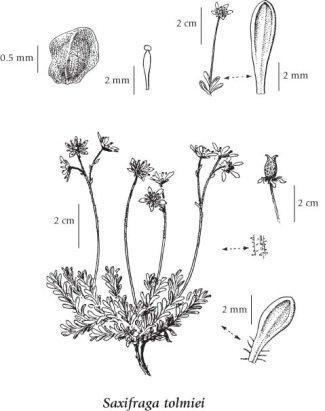Micranthes tolmiei
Tolmie's saxifrage
Saxifragaceae (Saxifrage family)
Introduction to Vascular Plants
Tolmie's saxifrage
Saxifragaceae (Saxifrage family)
Introduction to Vascular Plants
Species Information
General:
Perennial herb from slender, woody stem-bases; flowering stems 3-8 cm tall, smooth or purplish glandular-hairy, leafless or with 1 to 3 leaves, many sterile leafy branches.
Leaves:
Basal leaves few, if any; stem leaves numerous below, alternate, usually crowded, persistent for years, pear- to spoon-shaped or oblanceolate, 3-10 mm long, entire, fleshy, smooth or bases fringed.
Flowers:
Inflorescence of terminal, single flowers or clusters of up to 4, lower branches often with leaf-like bractlets; petals white, 2.5-5 mm long, elliptic egg-shaped to broadly oblanceolate, clawed or not; calyces saucer-shaped, joined to the lower portion of the ovary, free hypanthium absent, smooth, purple-tinged, the lobes oval to oblong egg-shaped, 2-3 mm long, spreading; stamens 10.
Fruits:
Capsules, 8-12 mm long, often purplish-mottled; seeds light brown, about 0.8 mm long.
Illustration

If more than one illustration is available for a species (e.g., separate illustrations were provided for two subspecies) then links to the separate images will be provided below. Note that individual subspecies or varietal illustrations are not always available.
Illustration Source: The Illustrated Flora of British Columbia
Ecology
Ecological Framework for Micranthes tolmiei
The table below shows the species-specific information calculated from
original data (BEC database) provided by the BC Ministry of Forests and Range.
(Updated August, 2013)
The table below shows the species-specific information calculated from
original data (BEC database) provided by the BC Ministry of Forests and Range.
(Updated August, 2013)
| Site Information |
Value / Class |
||
|
Avg |
Min |
Max |
|
| Elevation
(metres) |
1728 | 180 | 2480 |
| Slope
Gradient (%) |
17 | 0 | 70 |
|
Aspect (degrees) |
47 | 0 | 355 |
| Soil
Moisture Regime (SMR) [0 - very xeric; 4 - mesic; 8 - hydric] |
4 | 0 | 8 |
| Modal
Nutrient Regime
Class |
B | ||
| #
of field plots species was recorded in: |
63 | ||
| Modal
BEC Zone Class |
CMA | ||
|
All BEC Zones (# of stations/zone) species was recorded in |
AT(10), BAFA(17), CMA(24), ESSF(2), IMA(1), MH(8) | ||
|
Source:
Klinkenberg 2013
|
|||
Habitat and Range
Moist rock outcrops, streambanks, snowbed sites and scree slopes in the upper subalpine and alpine zones; frequent in the Coast-Cascade Mountains N to 57degreeN and Vancouver Island, rare on the Queen Charlotte Islands and in E BC; N to SE AK and S toMT, ID, NV and CA.Status Information
Synonyms
Synonyms and Alternate Names:
Saxifraga tolmiei Torr. & A. Gray